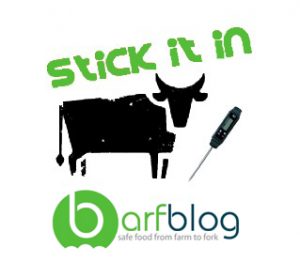I’m not really a salad fan. I know it’s not cool to admit that, but I love lots of other types veggies (so don’t email me about my nutrition)>
One of the salads I can handle (although it’s not my favorite) is Caesar – Romaine with a yogurt-based garlic, lemon and olive oil mixture with some asiago and bacon is doable.
Caesar and Romaine is off the menu right now after E. coli O157 has been linked to 18 cases in Canada and 32 cases in the U.S. 
Fascinating part of this one is (as PHAC states),
Laboratory analysis indicates that the illnesses reported in this outbreak are genetically related to illnesses reported in a previous E. coli outbreak from December 2017 that affected consumers in both Canada and the U.S. This tells us that the same strain of E. coli is causing illness in Canada and the US as was seen in 2017 and it suggests there may be a reoccurring source of contamination. Investigators are using evidence collected in both outbreaks to help identify the possible cause of the contamination in these events.
CDC notes that this outbreak is not linked to the one that was traced to Yuma.
Public health investigators are using the PulseNet system to identify illnesses that may be part of this outbreak. PulseNet is the national subtyping network of public health and food regulatory agency laboratories coordinated by CDC. DNA fingerprinting is performed on E. coli bacteria isolated from ill people by using techniques called pulsed-field gel electrophoresis (PFGE) and whole genome sequencing (WGS). CDC PulseNet manages a national database of these DNA fingerprints to identify possible outbreaks. WGS gives a more detailed DNA fingerprint than PFGE. WGS performed on E. coli bacteria from ill people in this outbreak showed that the strains were closely related genetically. This means that the ill people were more likely to share a common source of infection.
As of November 20, 2018, 32 people infected with the outbreak strain of E. coli O157:H7 have been reported from 11 states. A list of the states and the number of cases in each can be found on the Map of Reported Cases page.
Illnesses started on dates ranging from October 8, 2018 to October 31, 2018. Ill people range in age from 7 to 84 years, with a median age of 24. Sixty-six percent of ill people are female. Of 26 people with information available, 13 (50%) were hospitalized, including one person who developed hemolytic uremic syndrome, a type of kidney failure. No deaths have been reported.
Illnesses that occurred after October 30, 2018, might not yet be reported due to the time it takes between when a person becomes ill with E. coli infection and when the illness is reported. This takes an average of two to three weeks.
Ongoing outbreak and reoccurring source makes a recall (and no Romaine consumption) a good idea for now.
Over 80 outbreaks linked to leafy greens since 1995 – is pretty good justification.
 Problem is … the guy claims he was talking about butt bombs — not actual explosives.
Problem is … the guy claims he was talking about butt bombs — not actual explosives.







